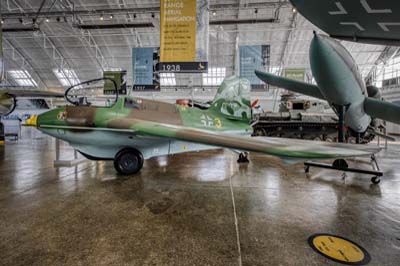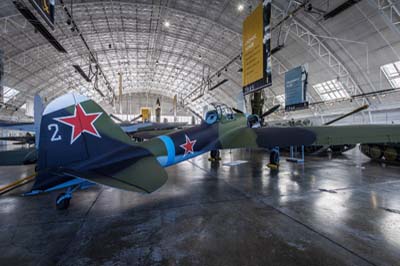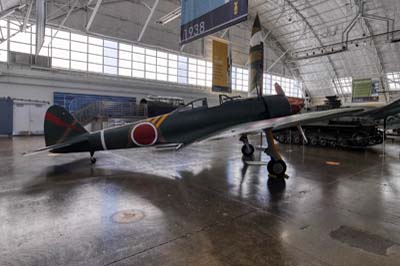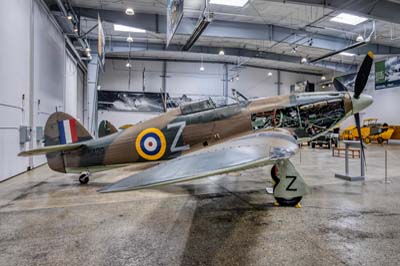Flying Heritage & Combat Armor Museum
Seattle-Paine Field, Everett, Washington
July 14, 2024
|
| A fabulous line up of wonderfully restored German, American, British and Japanese World War Two aircraft in Hangar B. |
The Flying Heritage & Combat Armor Museum (FHCAM) was created Microsoft Corporation co-founder Paul Allen. From 1998 he started the 'Flying Heritage Collection' by principally and restoring World War Two aircraft to the very highest standards.
The collection of aircraft opened to the public in 2004 at the Arlington, Washington, airfield. In 2008 his aircraft was moved to a renovated historic industrial hangar (Hangar A) located at Paine Field in Everett, Washington. In 2013 and again in 2018 new hangars (B and C) were constructed for the rapidly expanding collection. In 2017 the museum was renamed 'Flying Heritage & Combat Armor Museum'. Following the death of Paul Allen in 2018 and the museum's closure due to Covid-19 the collection was sold in 2022 to Steuart Walton, grandson of Walmart founder Sam Walton. He purchased the collection through his Wartime History Museum founded in 2022. The FCHAM reopened on Memorial Day Weekend of 2023.
Alpha Hangar |
 |
Left to right: Focke-Wulf Fw 190D-13 'Dora' (836017 '10 yellow' registered N190D). The Fw 190D-13 was the final version of the German Fw 190 fighter. They were fitted with a Junkers Jumo engine in the place BMW radials of the earlier versions. These 'long-nosed' Fw 190D also had a stretched aft fuselage to maintain the fighter's centre of gravity. The D-model proved to be the most successful examples of the 190 series, competing with the P-51 Mustang and late-model Spitfires on equal terms. However, Germany's lack of well-trained pilots and shortage of fuel at the late stages of the war made the new Fw 190 D a less than effective weapon.
This is the only Fw 190D-13 to have survived the war. The aircraft entered service in March of 1945 and served as the commander's plane of Jagdgeschwader (JG) 26. In May 1945, it was surrendered to the Allies and shipped to Freeman Airfield, Indiana, for evaluation. It was later given to Georgia Institute of Technology and then passed through several private owners before being acquired by Doug Champlin in 1972. In 2001, Gosshawk Unlimited completed the restoration. It was acquired by the FHCAM in 2007. |
Left to right: Messerschmitt Me 163B-1A Komet (191660 'yellow 3') ex German Air Force. The only rocket propelled interceptors to enter service. Around 370 Me 163 Komets were produced. Flying the very fast but volatile Me 163, Luftwaffe pilots of Jagdgeschwader (JG) 400 managed to shoot down nine allied aircraft from August 1944.
Built by by Junkers rather than Messerschmitt, this Me 163's first flight was made on December 18, 1944, when the partly-finished plane was towed as a glider between factories. The fighter was later delivered to Jagdgeschwader 400, its now known whether it ever flew in combat. Captured by the British on May 8, 1945, it was shipped to the Royal Aircraft Establishment in Farnborough for evaluation. In 1946, it was turned over to the Royal Air Force College in Cranwell. In 1961, it became part of the collection of the Imperial War Museum and was later displayed at at Duxford. Restored in 1997 it became part of the FHCAM in 2005.
Fieseler Fi 103R Reichenberg (44329). This is a manned version of the German V-1 flying bomb. Developed towards the end of the World War Two it was intended to be used as a human-guided bomb in suicidal attacks against the advancing Allies. Pilots were expected to bail out before it hit the target.
This manned V-1 was tested several times, killing every pilot on landing. A famed female test-pilot, Hanna Reitsch, discovered in simulated landing attempts that the craft had an extremely high stall speed and that the previous pilots had attempted their approaches too slowly. Once her recommendation was followed, pilot fatalities were reduced, but not ended. All of the Reichenbergs were air-launched from planes. The war ended before Germany could use the Reichenberg in combat.
The Soviet Army occupied the Nordhausen area and in 1948 they demolished the entrances to the underground missile factories. Almost 50 years later, a new entrance was found into the caves and these missiles were discovered there by restorers and enthusiasts. It was acquired by the FHCAM in 2001. |
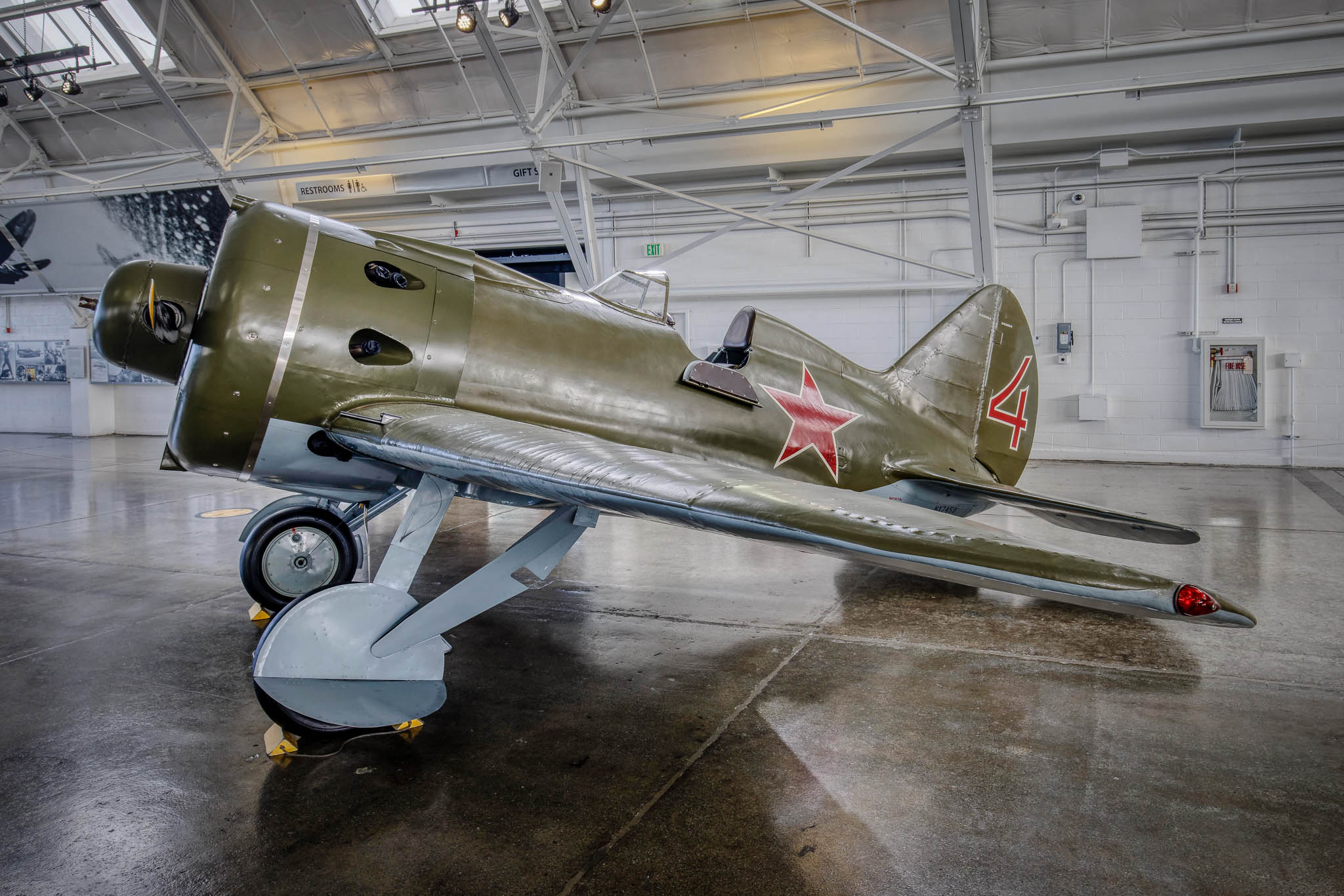 |
Left to right: Polikarpov I-16 Rata (2421014 '4 red' registered N7459). The sturdy I-16 was the world's first low-wing cantilever monoplane fighter with retractable landing gear, with a fully enclosed cockpit its design was ahead of its time. Soviet leader Joseph Stalin's demands for a technologically superior aircraft led designer Nikolai Polikarpov to create the Rata. Introduced in the mid-1930s it formed the backbone of the Soviet Air Force at the beginning of World War Two. Hundreds of I-16s were flown by Republican Forces during the Spanish Civil War. By World War II it had become technologically obsolete, but it continued to serve on the Eastern Front, fighting the Germans until 1943.
This airplane was built in 1940 and served on the Eastern Front during World War Two before it was most likely shot down by German or Finnish fire. The wreckage of this plane was discovered in 1991 and rebuilt at the same factory where it was originally manufactured at the Soviet Aeronautical Research Institute (Sibnia) in Novosibirsk. Restorers acknowledged that a number of the workers who rebuilt the plane had worked on the original I-16 production line as children. After passing to the Alpine Fighter Collection of New Zealand, it was acquired by the FHCAM in 1998. |
 |
 |
 |
Left to right: Polikarpov Po-2 (641543 '23' registered N46GU). The Po-2 is the most-produced military plane of all time. It was a reliable, uncomplicated, and forgiving aircraft, originally designed as a crop duster and training plane. t became famous when flown by female Soviet pilots in daring nighttime raids against German forces. Their tactics involved flying close to the ground, cutting their engines and then gliding through a bombing run, a very challenging and dangerous manoeuvre. To the Germans they were known as 'Nachthexen' (Night Witches).
This aircraft was manufactured in Russia in 1944 and flew on the Russian Front. It was recovered as a derelict airframe in Belarus and restored by the Polish Aero Club with a Polish-built engine. The FHCAM acquired the aircraft in 2000. |
Left to right: Ilyushin Il-2M3 'Stormovic' (305401 '2'). Designed as the tank-killing machine, the heavily armored aircraft help to push the Germans out of the Soviet Union. The Il-2 operated close to the ground, attacking enemy tanks, trucks, and troops near the front line.
The FHCAM's plane was restored by Retro Avia Tech with a reversed Allison V-1710-113 and using parts from four wrecks discovered in north-west Soviet Union. Il-2 serial number 305401 makes up a large percentage of the aircraft. Constructed in Kuybyshev in mid-1943, it was assigned to the 828th Attack Aviation Regiment on the lower Karelian Front. On October 10, 1944, the plane was hit by anti-aircraft fire while attacking an airfield and crashed near the Titovka River. The plane was discovered in a nameless lake by searchers flying a helicopter in 1991. |
Left to right: Nakajima Ki-43 Hayabusa 'Oscar' (750 registered N750N) ex Imperial Japanese Army Air Service. In total, 5,919 Ki-43s were produced.
Built by Nakajima at Ota during November 1942. Shortly after the end of the war, this Oscar was found in dense jungle near an airfield on Rabaul. The fighter had severe engine and propeller damage from a crash landing, but it was being repaired by Japanese soldiers. It was crated and shipped to Australia where it passed into the hands of many private owners. The FHCAM acquired the plane in 1999, it is the world's only surviving example.
de Havilland Mosquito T3 (TV959 registered ZK-FHC painted as 'NS838 UP-J') ex Royal Air Force. The Mosquito was designed to be fast, very fast. Constructed out of wood it was light and with conventional armament eliminated it was very light. It could carry 1,000 lb of bombs 1,500 miles at a speed of almost 400 mph. This was twice the speed of contemporary British bombers. Using the experience of building the DH.88 Comet Racer de Havilland conceived the aircraft in 1938, with the prototype day bomber taking to the air for the first time in November 1940. The Mosquito would eventually be used in a variety of roles, including; low-level tactical daytime bomber, high altitude night bomber, pathfinder, day and night fighter, trainer and for reconnaissance. Towards the end of its career it was used as a target tug. 7,781 were built the last was completed in 1950.
The museum's Mosquito was built in Leavesden, England, as a training aircraft in 1945. It wa one of the last Mosquito's to be retired from RAF service in 1963. Transferred to the Imperial War Museum (IWM) it appeared in the 1964 film 633 Squadron. After filming it went on display at the IWM until 1988. It was sold to the FHCAM in 2003 and sent to Avspecs Ltd in New Zealand for restoration to flight status, taking to the air once again in late 2016. It has since been painted to represent NS838 'UP-J', an FB.VI belonging to the RAF's 605 Squadron. |
Left to right: North American B-25J Mitchell (44-30254 ex RCAF 5211 registered N41123). The prototype B-25 Mitchell first flew in 1940 with initial deliveries commencing in the following year for the United States Army Air Forces (USAAF).
The FHCAM's B-25J was built in Kansas City at the end of 1944. It was one of 117 B-25s modified to carry a Hughes E1 fire control radar for training. The plane served with the Royal Canadian Air Force for ten years until it was sold as surplus in 1961. Purchased by Cascade Drilling Company of Calgary and converted to a water-carrying 'fire bomber'. In the mid-1990s, it was purchased by the museum and restored to its wartime configuration by Aero Trader in Chino, California.
Republic P-47D Thunderbolt (45-49406 '2Z-T' painted as '433133' ex FAB 4192, registered N7159Z). Designed as an high altitude interceptor, the prototype Thunderbolt first flew in May 1941 entering service the following year, eventually 12,956 were constructed. The P-47 had heavy armour, eight guns, and a powerful radial engine. It weighed nearly five tons empty, more than any existing single-engine fighter. Its first assignments were bomber escort, but after D-Day, most P-47s fought close to the ground in the fighter-bomber role, attacking enemy trains, tanks, and troops in front of advancing Allied armies in France and Germany. The Jug as it was known was legendary for its ability to absorb battle damage and still make it home.
This P-47 was manufactured in Evansville, Indiana, and delivered to the USAAF on June 27, 1945. After serving with the US Air National Guard, it was transferred to Brazilian air force in the 1950s. In the 1980s the plane was shipped back to the United States. The FHCAM bought the P-47 in 1998. |
 |
Left to right: Curtiss P-40C Warhawk (41-13390 painted 'P-8194' registered N2689) ex USAAF. The P-40 was built at Curtiss-Wright Corporation's main production facilities in Buffalo, New York. Designed as a single-engined, single-seat, all-metal fighter-bomber, it was based on the Curtiss P-36 Hawk and first flew in 1938. It was the third most-produced American fighter of World War Two, after the North American P-51 Mustang and Republic P-47 Thunderbolt. Production ended in November 1944 after 13,738 had been built.
This aircraft was bought by the British and passed to the Soviet Union in 1941. Over the next year it flew combat missions over the Karelian Front in Russia, defending Murmansk against invading German forces. Major Ermakov was flying the aircraft on September 27, 1942 when the oil tank was punctured by enemy fire. Ermakov managed to glide the aircraft to a safe belly-landing on a patch of snowy ground near Murmansk, where it was abandoned. Discovered in the early 1990s it was recovered and eventually transported to Chino, California for restoration before passing to FHCAM in 1999.
Curtiss JN-4D 'Jenny' (c/n 3712 registered N3712). The Curtiss JN 'Jenny' is a series of biplanes built by the Glenn Curtiss Aeroplane Company of Hammondsport, New York, later the Curtiss Aeroplane and Motor Company, produced as a training aircraft for the US Army and US Navy. Production began in 1915 and became North America's most well known aircraft of World War One, training 95% of student pilots in the US and Canada. A Jenny was used for the world's first radiotelephony from one aircraft to another and from ground to air and vice versa in test conducted in July and August 1917. Also, a Jenny was the first utilised for the US Air Mail in May 1918.
The JN-4D model, on display, was the definitive version of the Curtiss JN series. Introduced in 1917, shortly after the United States entered World War One, it was one of several improvements Curtiss made to his aircraft design. Notably, the JN-4D replaced the earlier control wheel with a control stick to operate the ailerons, which were now located only on the upper wings.
This example was manufactured in 1918 and served at March Field in Riverside, California. In 1999 it was acquired by the museum and rebuilt and restored in a US Army configuration. Around 35 Curtis Jennys survive today from a total of 6,813 built. |
Left to right: North American P-51D Mustang (44-72364 'SX-L' ex FAD 1916, ex SweAF 26115 registered NL723FH) ex USAAF. Perhaps the best fighter of World War Two, the P-51 Mustang was built from 1940 by North American Aviation to a British specification.
This P-51 served with the Eighth Air Force's 353rd Fighter Group. It was assigned to Captain Harrison "Bud" Tordoff, who flew the aircraft during many of his air-to-air combats, including the day he shot down a German Me 262 jet fighter. After the war, tit was transferred to the Royal Swedish Air Force and then went on to the Dominican Republic. It spent more than 30 years in the Caribbean. The FHCAM acquired the aircraft in 1998. This Mustang is restored to be almost exactly the same as it was in 1945. |
Left to right: Focke-Wulf Fw 190A-5 (1227 'A' registered N19027). When the Fw 190 entered the war in 1941 the German Fw 190 was the most advanced radial engine fighter in the world. As a dogfighter it was, fast, light, and small and more than a match for the Spitfire. Heavily-armed and immensely strong, it also very capable in the ground attack roles as well.
This Fw 190 was built in 1943 and factory-modified for the ground attack role. Deployed to the Eastern Front, it was assigned to Jagdgeschwader (JG) 54 near Leningrad. On July 9, 1943, while attacking a Soviet supply train, the plane crashed. The pilot became a prisoner in Russia, but his plane remained untouched and hidden by acres of impassable wetland. The amazingly intact plane was discovered by a warbird hunter in the late 1980s and was carefully dismantled and airlifted by helicopter. In England and later in the United States it underwent an extensive restoration process. Today, the plane is the only original flyable Focke-Wulf 190A fighter to take to the skies with a genuine BMW 801 engine. |
 |
 |
Left to right: Mitsubishi Zero A6M3-22 (3852 'UI-161' registered N3852) ex Imperial Japanese Navy Air Service (IJNAS). The Mitsubishi A6M outclassed every American fighter at the beginning of World War II. Called the 'Zero' by the Allies, the A6M could out climb, out turn, and out run almost anything in the air. However, it became less effective once the Allies began exploiting its weaknesses, most notably its lack of armour and self-sealing fuel tanks. New American fighter designs closed the performance gap as Hellcats, Mustangs, and Corsairs began to arrive in the Pacific in great numbers.
The wreckage of this Zero was one of three found in New Guinea in the early 1990s by a warbird hunter. They were sent to Russia for restoration using salvageable parts and components made by Russian technicians. In order to operate reliably, they were fitted with a specially-modified US designed radial engine created by Fighter Rebuilders in Chino, California. Purchased in 1998 the FHCAM's Zero was modified to carry two passengers.
|
Left to right: Supermarine Spitfire LFVC (AR614 'DU-Z' marked '5429' registered N614VC) ex Royal Air Force. The first Spitfire Mk.1s entered service in August 1938 and by the outbreak of war nine squadrons were equipped with them. The Spitfire was the only aircraft that could match the German Messerschmitt Bf 109E in aerial combat during the Battle of Britain.
This airplane was allocated to the Czech 312 Squadron, RAF on September 11, 1942. Squadron Leader Tomas Vybiral was piloting this plane when he led his squadron on a daring wave-top raid against enemy shipping at St. Peter Port, Guernsey. On that day, his plane was hit by flak just behind the cockpit, narrowly missing Vybiral. After extensive repairs, the Spitfire served with other RAF units during the war. After the war it was used as an instructional airframe, gate guard, and display. In 1964 it was classified as scrap and sold to a museum in Canada. The FHCAM purchased the Spitfire in 1999.
Hawker Sea Hurricane XIIA (BW881 'Z' registered N54FH) ex Fleet Air Arm. The navalised Hurricanes, known as Sea Hurricanes, would be a vast improvement on the Fleet Air Arm's aircraft currently in service. Operating from aircraft carriers they would see action in the Battle of the Atlantic and the invasion of North Africa in 1942. In total 38 Fleet Air Arm squadrons used the type with the last Sea Hurricanes being phased out of service during September 1944.
This Mk.XIIA was manufactured by Canadian Car & Foundry Company at Fort William, Ontario. It was powered by a U.S. Build Packard Merlin XXIX engine. It was delivered to the Royal Canadian Air Force (RCAF) on January 22, 1942, but never saw combat. After the fighter was involved in a crash landing, it was discarded by the RCAF. After it was recovered from a farm in Ontario, Canada, Hawker Restorations Ltd. rebuilt the fighter at Milden, England. The first flight of the restored aircraft took place on March 15, 2006 at Wattisham, England. |
 |
Left to right: Messerschmitt Bf 109E-3 (1342 registered G-BYDS, NX342FH). The Bf 109 was one of the finest single seat fighters from World War Two with 33,000 being produced. It was designed in 1935 and performed very well during the Spanish Civil War. It was only matched by the Spitfire's and Hurricane's performance. It could out climb both and was faster than the Hurricane but not the Spitfire. Its main limiting factor was its limited endurance as it could only engage in combat over England for a few minutes. A fighter-bomber version was introduced in 1940.
This example was built at the Erla Maschinenwerke factory at Leipzig in October 1939 as an E-3 variant, known as the 'Emil'. Part of a batch of 484 built between August 1939 and May 1940, it was werk nummer (manufacturer's serial number) 1342.
1342 was issued to Jagdgeschwader 51 and assigned to Feldwebel Eduard Hemmerling of the unit's 6th Staffel. Hemmerling fought in the Battle of France. During Battle of Britain which began on July 10, Hemmerling was escorting a force of 48 Junkers Ju 87 'Stuka' dive-bombers and was engaged in a dogfight over Dover. 1342 was hit in the combat and Hemmerling turned back towards France. He didn't make it and crashed on the coast of Cap Blanc Nez. The 27-year-old Luftwaffe pilot died of his injuries.
A man walking on the beach near Calais in 1988 saw a piece of metal sticking out of the sand, it was the wingtip of 1342. The wreckage was recovered and sent to England for restoration at Craig Charleston's Charleston Aviation Services workshop near Colchester, England. It was placed on the British civil register as G-BYDS in November 1998 for New Zealand based Sir Tim Wallis's Alpine Fighter Collection. Prior to first flight, the Messerschmitt was acquired by Paul Allen and registered to Flying Heritage as N342FH in November 2004. The first engine and taxi runs were carried out at Wattisham, Suffolk, in February 2005. Shipped to the USA, 1342 was re-assembled at Arlington, Washington and then Steve Hinton carried out the Bf 109's first flight in 68 years on March 22, 2008. Happy with its performance, Hinton ferried the fighter to Paine Field. |
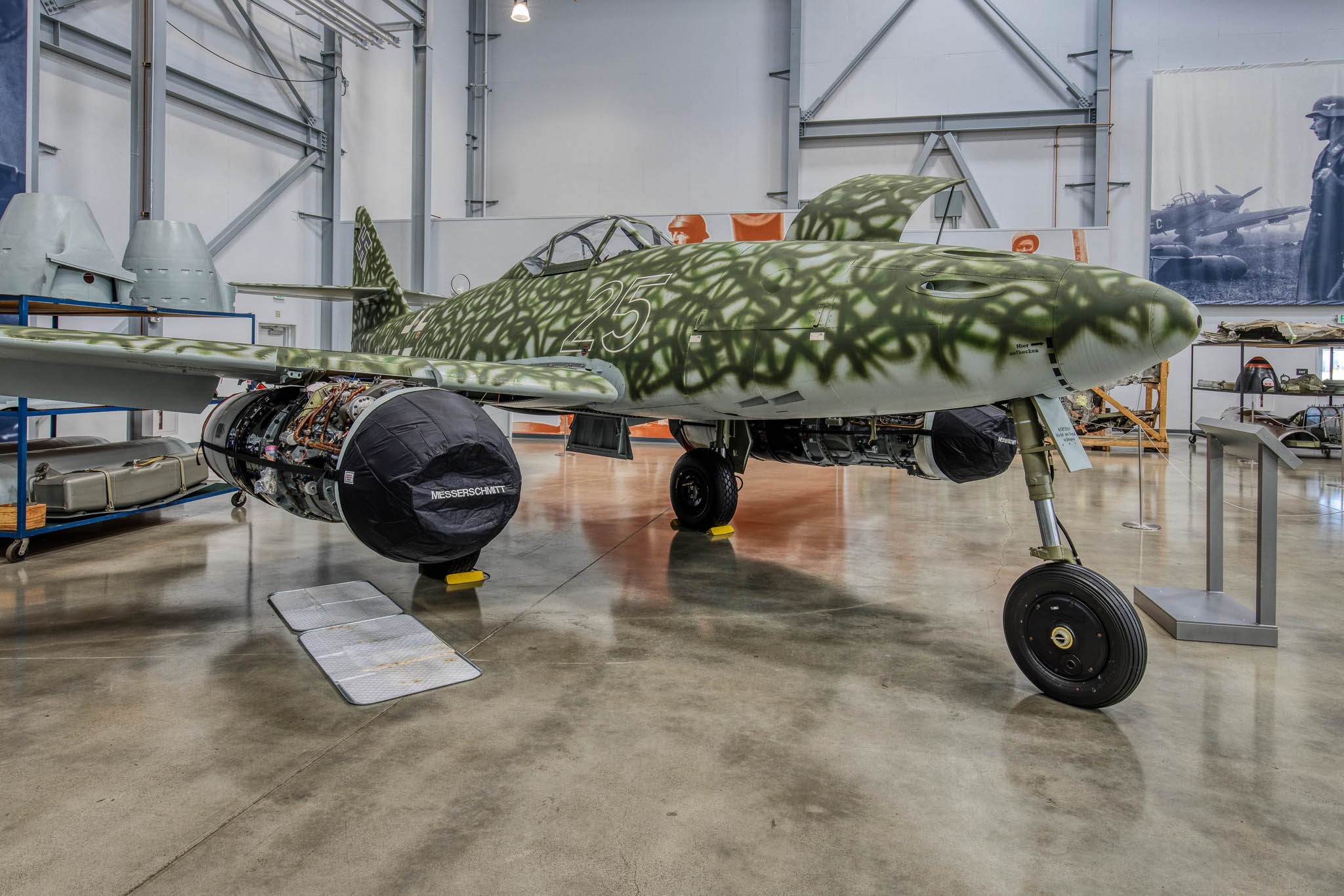 |
Left to right: Messerschmitt Me-262A-1a/U3 Schwalbe 'Swallow' (500453 'white 25') ex German Air Force. This was the most advanced fighter of World War Two. Design work began in 1938 but problems with the revolutionary turbojets delayed the first flight till July 1942. An interfering Hitler insisted that it be manufactured as a fighter bomber and as such it was not operational till summer 1944. As a fighter the Me262 was formidable but the small numbers produced meant that it had little impact during the war.
This example was built at Obertraubling near Regensburg, south-east Germany during early March 1945, then moved by rail to Memmingen in Bavaria, where it made its first flight on March 14. It was found and captured at the Lechfeld Airfield, Germany on April 27, 1945. It was built as a reconnaissance version with two large cameras fitted in its nose. The US Army's 54th Air Disarmament Squadron transported the jet by road to Cherbourg, France for shipment to the United States on HMS Reaper to join the Operation LUSTY (LUftwaffe Secret TechnologY) test programme. The USAAF fitted a smoothly contoured nose for testing. After over four hours of flight testing it was abandoned, by 1955 it was near-derelict when it was acquired the Planes of Fame collection at Claremont, California. Paul Allen bought the jet in 2000 for his collection. After 15 years of restoration which included the fitting of two Jumo 004 engines which enabled it to taxi under its own power. |
 |
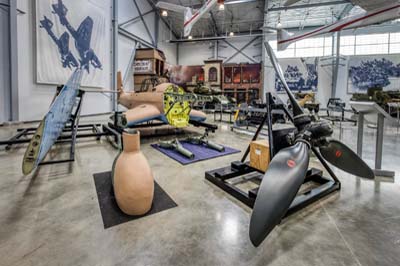 |
Left to right: Fieseler Fi 156 C-2 Storch (4362 '2E+RA') German Air Force. Designed in 1935 the Storch was able to fulfil a variety of roles due to its incredible Short-Take-Off and Landing (STOL) capabilities. 2,549 examples were built in Germany, Czechoslovakia and France.
THis aircraft was found derelict in East Germany in the 1980s and is believed to be built at the Fiesler Werke factory in late 1939. It was restored in Michigan in the 1980s and 90s, the FHCAM bought the aic raft in 2000. It is restored in the colours of an aircraft deployed to the Eastern Front under Operation Barbarossa.
Junkers Ju 87R-2 Stuka (6234 L1+FW). The Ju 87 was widely known as the 'Stuka' (German for dive-bomber) and entered service in 1938. It first saw action during the Spanish Civil War (1936 to 1939). It was very successfully used against Poland and France before being employed to attack shipping in the English Channel. It went on to destroy more ships than any other aircraft in history. After its role was switched to attacking coastal airfields and radar stations it began to suffer heavy losses due to its poor defence against enemy fighters. They were later moved to the Russian Front to attack tanks.
This example was built in 1941 and served with Lehrgeschwader 1 and later Sturzkampfgeschwader 5, German Air Force. On a mission to bomb Murmansk in April 1942 it was attacked by Soviet fighters and crashed to the west of the city. The wreckage remained in the wilderness until the early 1990s, when it was acquired by a private collector and shipped to England and later passed to the Deutsches Technikmuseum (German Museum of Technology) in Berlin in 1997. The FHCAM began a restoration to flying condition in 2013. It is one of only three surviving Stukas left in the world. See Hellenic Air Force Museum and RAF Museum Hendon for the other two surviving Ju 87s. |
Left to right: Goodyear FG-1D Corsair ('523' registered N700G). The Corsair first flew in March 1940, and production Corsairs joined the Marine Corps fighter squadrons on Guadalcanal in February 1942 and later in 1944 to aircraft carriers. The inverted gull wing design enabled the fitting of large propeller with the huge radial engine, while keeping the overall height of the aircraft within the limitations imposed by carrier use. The FG-1D fighter-bomber version of Corsair was able to carry a bomb or rocket load in support of ground troops. Although a Chance Vought design, Corsairs were also built under contract by Brewster and Goodyear. The latter built 4,017 Corsairs with the 'FG' designation.
This aircraft was built in Akron, Ohio in April 1945. It was assigned to VMF-115 of the US in the southern Philippines in July and August 1945. The Marines were based at Zamboanga and flew close air support and combat air patrols. After the end of the war it rotated through a number of training commands before disposal in 1958. Under civilian ownership, it was flown at the Flying W airpark in New Jersey, exhibited at a museum, and flown off the USS Carl Vinson in August 1995 during the celebration of the 50th anniversary of the end of World War II. The FHCAM acquired the aircraft in September 1998.
Grumman F6F-5 Hellcat (79863 '32'). The US Navy's Hellcat dominated the skies over the Pacific during World War Two. The F6F was designed to outperform the Mitsubishi A6M 'Zero'. By the end of the fighting, the Hellcat had destroyed over 5,000 Japanese aircraft in the air. The Hellcat's large wings accommodated the slow take-off and landing speeds on an aircraft carrier. To compensate for the plane's size, crewmen could fold the plane's wings for storage. In total, Grumman produced 12,275 F6Fs during World War Two.
This F6F was built as a night-fighter but never flown in combat. After the war, it was modified to be an unmanned drone for anti-aircraft target practice, but was saved from destruction when diverted for flying training. It was one of the last Hellcats to leave the Navy's inventory in 1961. The fighter was displayed in several museums and private collections. It appeared at Oshkosh and other airshows in the 1970s, was on hand for Grumman's 50th anniversary in 1980, and flew across the Atlantic Ocean via Iceland in the 1990s. It was acquired by the FHCAM in December of 2000. |
 |







